A Leaf of Deuteronomy from ‘Otto Ege Manuscript 14’ in the Rosenbrook Collection
February 8, 2022 in Manuscript Studies, Uncategorized
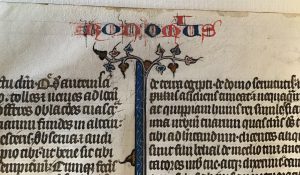
Brent Rosenbrook Collection, Leaf from Ege Manuscript 14, ‘Recto’ (original Verso), top: Running title.
An Old Testament Leaf
from ‘Otto Ege Manuscript 14’
with part of Deuteronomy
in the Rosenbrook Collection
Large-format Latin Vulgate Lectern Bible
made in France
late 13th- or early 14th century
Single Leaf within a matted frame
Double columns of 50 lines
Maximum measurements circa 16 1/8″ × 10 11/16″ <written area circa 11″ × 7 3/8″>
Deuteronomy 11:21 ([quam iuravit] /) dominus patribus)
– 14:15 (strutionem ac noc-(/tuam et larum])
With bichrome running titles and chapter numbers,
polychrome decorated initials and border ornament with geometric and foliate motifs,
and added lection marks
[Posted on 8 February 2022, with updates]
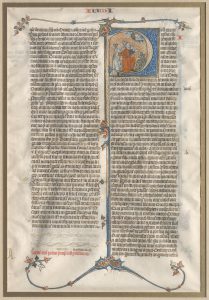
Virginia Lazenby O’Hara Fine Books Division, Dallas Public Library, Framed Leaf from Otto Ege MS 14, ‘Recto’ (original Verso).
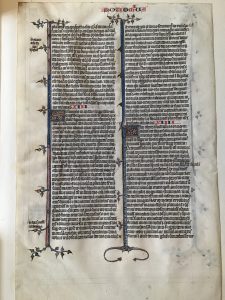
Brent Rosenbrook Collection, Matted Leaf from Otto Ege Manuscript 14, ‘Recto’ (original Verso).
Continuing the series of posts for our blog on Manuscript Studies, Mildred Budny describes another leaf from ‘Otto Ege Manuscript 14’, a large-format copy on vellum of the full Latin Bible in the Vulgate Version.
A leaf from this manuscript recently reached the collection of Brent Rosenbrook, who generously sent images and information about it, in response to the blogpost reporting More Discoveries for ‘Otto Ege Manuscript 14’.
A similar response several months ago brought to our attention the Dallas Leaf from the same manuscript, now kept at the Virginia Lazenbury O’Hara Fine Books Division of the Dallas Public Library in the City of Dallas, Texas. A report of that leaf, which carries the end of the Book of Joshua and the beginning of Judges in the Old Testament portion of the manuscript, appears in our blog on A Leaf in Dallas from ‘Otto Ege Manuscript 14’.
The ‘new’ leaf likewise comes from one of the early Books of the Old Testament. In the sequence, it stood one Book ahead.
Otto Ege Manuscript 14 and Manuscript Studies
Some discoveries for the manuscript have been reported in our blog.
- A New Leaf from ‘Otto Ege Manuscript 14’
- More Discoveries for ‘Otto Ege Manuscript 14’
- A Leaf from ‘Otto Ege Manuscript 19’ and Ege’s Workshop Practices
- Updates for Some ‘Otto Ege Manuscripts’ (Ege MSS 8, 14, 41, and 61)
- Some Leaves in Set 1 of ‘Ege’s FOL Portfolio’ (Ege MSS 8, 14, 19, and 41)
- Patch Work in ‘Otto Ege Manuscript 14’
- A Leaf in Dallas from ‘Otto Ege Manuscript 14’.
See also The Illustrated Handlist (Number 4).
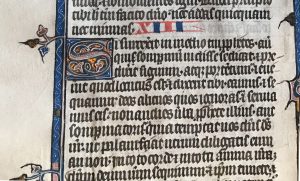
Brent Rosenbrook Collection, Leaf from Ege Manuscript 14, ‘Recto’ (original Verso), middle right: Deuteronomy 14 opens.
The Rosenbrook Leaf
When contacting me about the Leaf, its collector described the origins of his collecting spirit and the development of his book-collecting.
I wanted to give you a little bit of backstory and brief history. I am a layman in this field but have always been a collector of things since my childhood. I was a bibliophile long before I ever heard the term or would have understood its meaning. And although I am new to collecting illuminated manuscripts, I have always felt drawn to the beauty of them. As a teenager and young man I was especially stuck by the intricate, amazing imagery and knotwork in the Book of Kells. In 1998 I was fortunate to have visited Trinity College in Dublin and see it firsthand along with other books on display. It was a moment of wonder to finally be in the presence of that book. Although I never lost that sense of awe, for the next many years that was the extent of my experience and attention concerning manuscripts.
In December of 2016 my wife and I were visiting a friend’s home for the holidays when I noticed on the wall a large framed musical page of some sort. I could tell that it was hundreds of years old, handwritten, on animal skin. He knew little about it other than it belonged to a relative down the line and that at some point it was gifted to him. It was of course an antiphonal as I later discovered by searching online. It was (is) likely early 16th century and had one very large, but simple rubricated initial. Although it wouldn’t be considered elaborate or rare to a person knowledgeable in such things, for me the affect was basically “Wow, that’s really cool. I’ve got to figure out what that is. I want one of those”. The collector bug bit me again. . . .
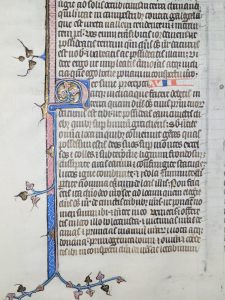
Brent Rosenbrook Collection, Leaf from Ege MS 14, ‘Verso’ original Recto), bottom left.
My interest and enjoyment of looking at and learning about illuminated manuscripts (especially Bibles with historiated and zoomorphic initials) grew as I visited multiple websites over many weeks and scrolled through countless images of various western manuscripts. In March 2017 I acquired my first true illuminated leaf when I bid on and (unexpectedly) won a large Bible leaf which was from a manuscript previously owned by the famous collector Chester Beatty. As far as the Otto Ege leaf, it was a spontaneous purchase.
I received a notification . . . when this page was listed recently by Rodger Friedman Rare Book Studio. It wasn’t on my radar (or necessarily in the budget) to make a purchase but after glancing at the listing throughout the day I committed to buying it. I only knew the name Otto Ege vaguely through my reading up on manuscripts.
When I received the package and saw the leaf for the first time it evoked a lot of emotion. Although I knew its measurements when I purchased it, I still wasn’t prepared for the size and beauty of seeing it firsthand – it is stunning. It was only in the last few weeks after this acquiring this that I began reading up on and watching video postings about this famous biblioclast and the sets he sold off. . . . It was just this past Thursday night when I came across the RGME website and decided to reach out to you.
As for the Leaf itself, the collector reports that “It remains in the original matting that Ege used when he compiled these books.” Thus, this specimen qualifies for the group of survivors from the manuscript which circulated on their own
, as a ‘Rogue Leaf’. Many of them traveled within one of Ege’s standard mats of a uniform size, accompanied by Ege’s printed Label giving a generic description of his Leaf 14. They resemble the presentation designed for specimen leaves from various manuscripts in Ege’s ‘FOL’ Portfolio of Fifty Original Leaves from Medieval Manuscripts, in which leaves from the dismembered Lectern Bible have the position of Number 14.
Now, with the collector’s permission, the Leaf might begin to assume its place within the virtual Reconstruction of the manuscript, as known from its fragments. Brent Rosenbrook observes:
I think it’s nice for others to know that there are those who aren’t necessarily part of academic institution but still would like to contribute what they can to the advance of manuscript study.
We greatly admire this view!
A Note on the Photographs of the Leaf
The images here show the Leaf and its details under several forms of light, taken at different times and at different angles. Their variety shows multiple aspects, including some 3-dimensional features which views at an angle can reveal of the curvature of the surface(s) of the animal skin and the furrows of the ruled lines upon it in drypoint.
Ege’s Printed Label, Annotated
Let us start with the printed Label, which stands, as customary for Ege’s mats, at the lower left of the windowed front of the hinged bifold mat.
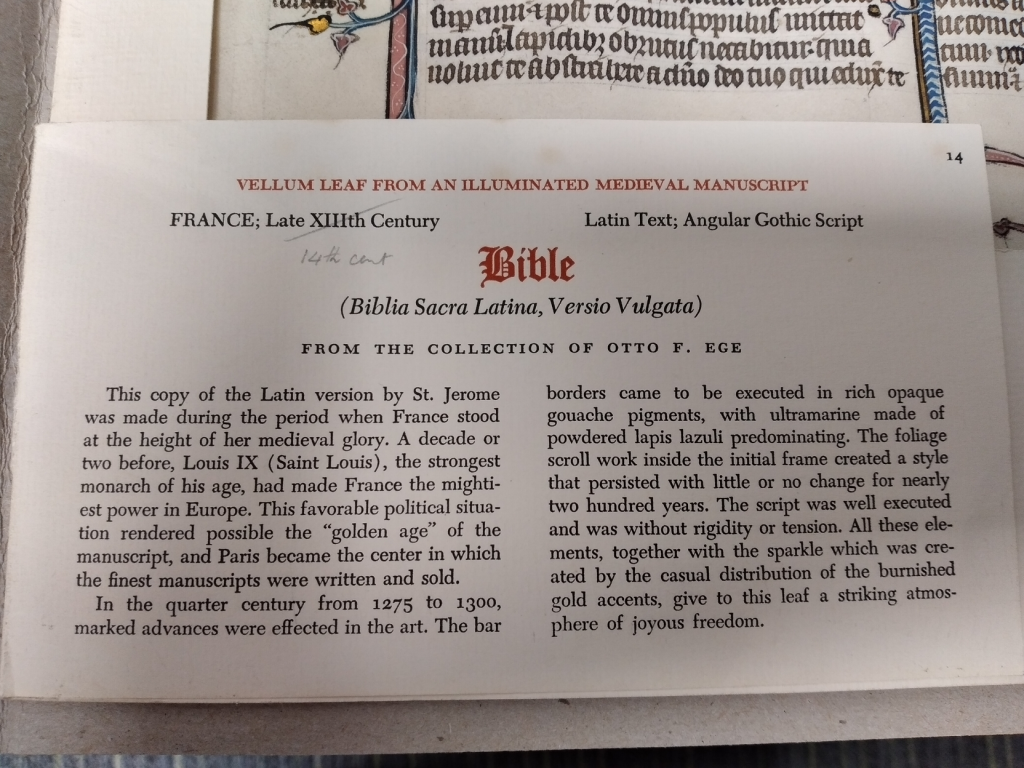
Brent Rosenbrook Collection, Leaf from Ege Manuscript 14, Printed Title.
An earlier blogpost has considered in detail the text of Ege’s printed Label for this manuscript and its merits. See:
Some blogposts note instances of a few annotations upon Ege’s Labels for this or other manuscripts.
- A Leaf in Dallas from ‘Otto Ege Manuscript 14’.
- A Leaf from ‘Otto Ege Manuscript 19’ and Ege’s Workshop Practices.
In the case of the Rosenbrook Leaf, a pencil annotation revises the attribution of the date of the manuscript from the printed “Late XIIIth Century”. It does so by cancelling that date (or part of it?) with a long diagonal stroke descending to the left across the numeral, and by replacing it with “14th cent”. Given the extent of the long diagonal slash across the breadth of the printed attribution, it is perhaps debatable whether or not the revision is intended to retain the printed qualifier “Late”.
Ege’s Mat, Annotated
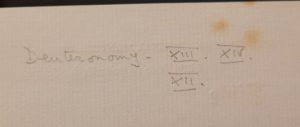
Brent Rosenbrook Collection, Ege 14 Mat, Back, Top Center.
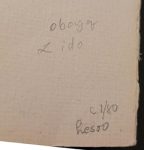
Brent Rosenbrook Collection, Ege 14 Mat, Front, Bottom Right. Sellers’ marks.
The mat carries two sets of notes written in pencil. One stands at the top on the back; the other fits into the lower right-hand corner on the front. Written in different hands with softer or sharper implements, they state the textual contents on the Leaf and provide a set of marks in cryptic form.
In two lines, the note on the back cites the name of the Book (in English) and the chapter numbers, in roman numerals as they appear prominently on the leaf, but with the medieval XIIII rendered (or modernized) as XIV. The annotation resembles some notes on other Ege leaves or mats.
Deuteronomy — XII. XIII. / XIV.
The notes on the front provide two sets of marks, in two lines each. Their forms resemble many modern sellers’ intentionally cryptic marks for inventory and prices. These notes appear to pertain to more than one campaign, as the Leaf may have passed through more than one vendor’s hands.
oboyg / L[or α?] ido
c/180 / hes[or 5?]00[or oo]
The last element (call it ‘hesoo’) partly overlies a partly erased note. “Perhaps a number (257?)”, Rosenbrook suggests.
[Update on 11 February:
Peter Kidd observes (see the Comment below) that: “This leaf comes from Ege “Fifty Original Leaves” portfolio no. 39, sold at Christie’s, 30 January 1980, lot 212, bought by Maggs for £2,600. This can be deduced from the fact that one of the inscriptions is a characteristic Maggs acquisition code: C 1/80 = Christie’s, January 1980 hesoo = £150.00″.
Another set of the same Portfolio (Number 1) sold at Christie’s more recently, as shown here. On its Leaf from ‘Ege Manuscript 14’, see Some Leaves in Set 1 of ‘Ege’s FOL Portfolio’.]
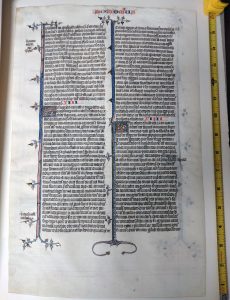
Brent Rosenbrook Collection, Leaf from Ege Manuscript 14, ‘Recto’ with measuring tape.
The Leaf
Viewed through the front of the mat (see the photograph above), the leaf appears cropped, as the window overlies its four sides. Opening the mat reveals the full extent of the leaf insofar as it survives.
One side of the leaf faces front. We will call it the ‘Recto’, as it stands within Ege’s mat. The other side, the ‘Verso’, might be seen by lifting the leaf by its loose right-hand side, much as one might turn the pages from front to back in a Western-style book — that is, a book in which the lines of text run from left-to-right. (Ege employed that same approach, to their detriment, to matting the leaves removed from books in other, non-Western, languages written in other directions.) Such an approach might be thought to approximate the experience of encountering the book itself (and not only a leaf from it), by turning one page.
Ege’s ‘Recto’ — the Original Verso
On the first side of the leaf, each column of script has a decorative polychrome border in the form of a vertical bar standing at the left-hand edge, with foliate offshoots. This narrow bar contains strip-like panels filled with frieze-like geometric or foliate patterns. Each bar attaches to, and extends upwards and downwards from a more-or-less rectangular frame of three lines height inset within the column for the chapter initial. The frame contains the full letter (S for Si, “If”) or its body (F for Filii, “Sons”). The bar extends both above and below the inset frame for the former, and below the frame for the latter, functioning as the stem or the back and tail. In the end of the line above that frame, and the first line of the chapter, there stands the bichrome numeral of the chapter: respectively XIII in column a and XIIII (i. e. XIV) in column b.
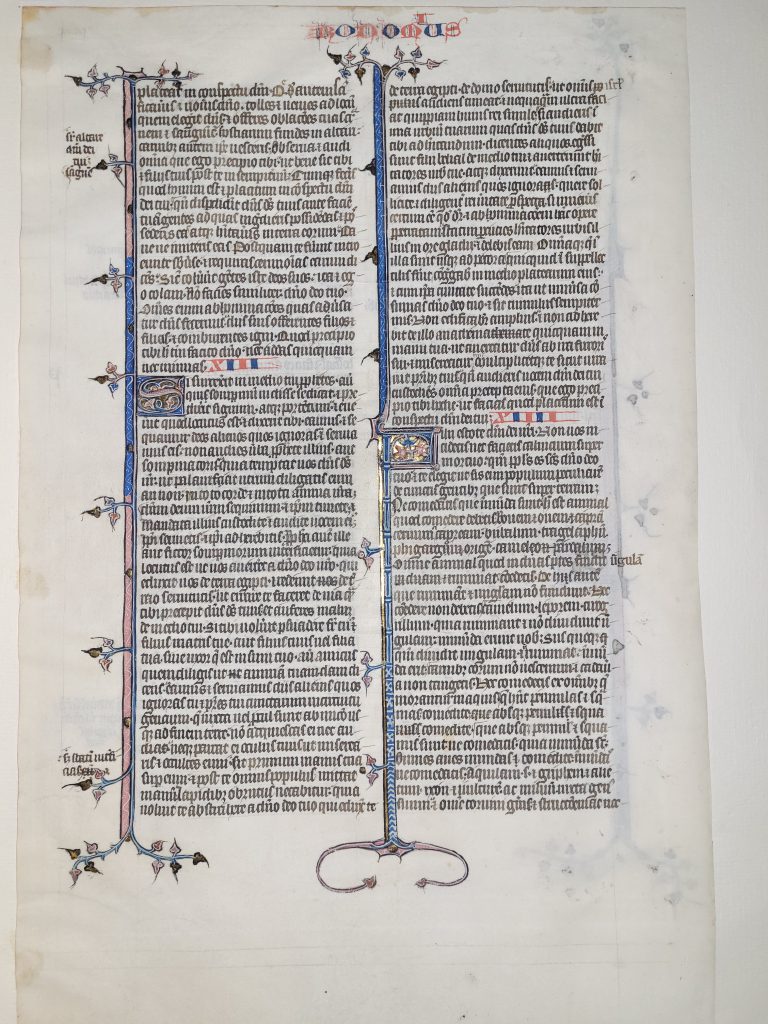
Brent Rosenbrook Collection, Leaf from Ege MS 14, ‘Verso’ (original Recto).
At the top of the page, the bichrome running title announces part of the polysyllabic name of the Book of the Bible: [DEUTE-]-RONOM‘I‘US. In the copying, the rubricator missed a letter, but then inserted it neatly above the pair of letters between which it should stand, with the same red and blue pigments and style of script, but in a somewhat smaller scale. This correction evidently formed part of the process of painting the title, with the same pigments, implements, and scribal hand in place. Given the standard alternation between red and blue letters, and the established pattern already set in the line of letters, the choice of red for the smaller, raised, and inserted letter allows it to blend in rather smoothly with the color scheme.
A few other corrections, but in ink, improve the text as it had been copied. Examples included some letters crossed out with horizontal lines through them (as in line 18 of column b) and entries of one or more words in the margins opposite their intended locations within the course of the text. A matching pair of signes-de-renvoi, placed to the upper left of the start of the added phrase and within the line of text, signals the point within the text where the addition is to be read.
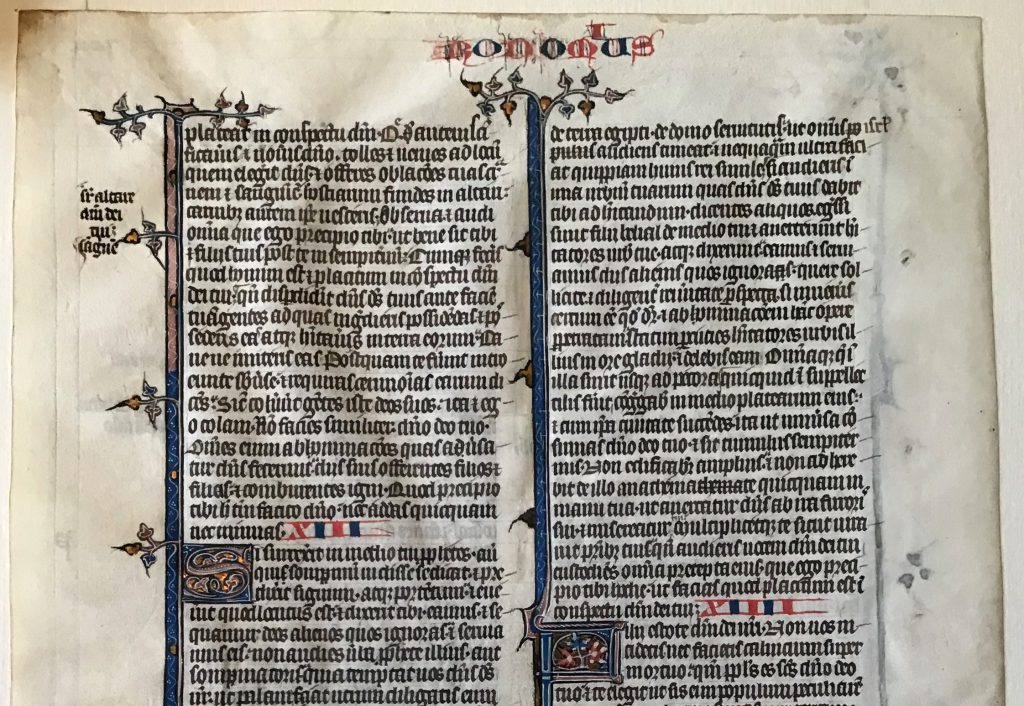
Brent Rosenbrook Collection, Leaf from Ege Manuscript 14, ‘Recto’ (original Verso), top.
Ege’s ‘Verso’ — the Original Recto
The other side of the leaf has only one chapter initial, plus vertical bar, for the chapter numbered XII. The ensemble adorns column a. In this case, the bar extends only partway down the margin (from line 12 downward), but its foliate offshoots at top and bottom reach not only into the lower margin, but also, beyond the bar, far into the upper margin, where the trimmed upper edge of the leaf cuts off its uppermost tip. A similar fate has befallen the lowermost extension at the bottom of the leaf.
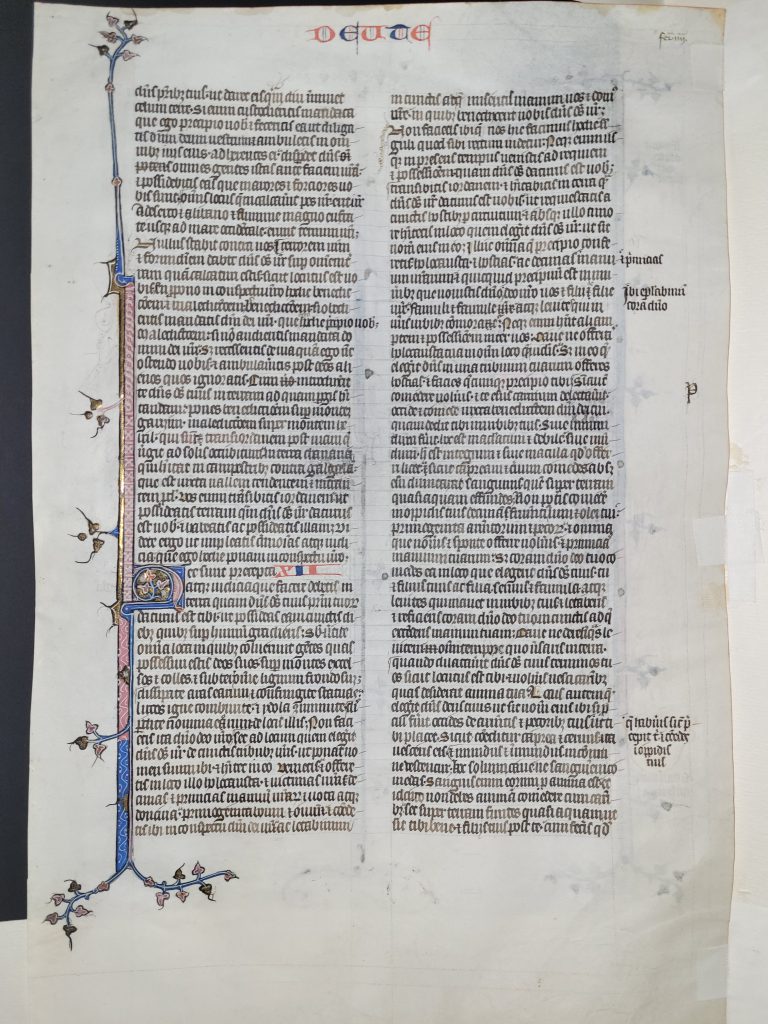
Brent Rosenbrook Collection, Leaf from Ege MS 14, ‘Recto’ (original Verso).
The diverted course of the vertical bar seems pre-set by the presence of the expansive initial N (of Nullus) in line 11. Rendered in ink, as customary for the initials of the Biblical verses, this letter assumes an unusually broad width and has a decorative pen-line flourish descending into the margin beside the next two lines. In a later stage of the course of production, the polychrome bar for the chapter initial lower down in the column performs a side-step around this letter.
Corrections to the text stand in the right-hand margin only. Midway down that margin, there stands a lection mark: a capital letter P in ink.
The upper margin has the first part of a running title: DEUTE-.
Close to the top right corner, there stands another mark in ink to indicate a lection: fer[ia] iiij’ [for quarta] (“feria iv”). It indicates the fourth feria among a string of days other than the Sabbath (but not any saints’ feast days). In the customary numeration, Feria IV would be Wednesday, with Monday counting as Feria II. (The revised common lectionary, Year C, Wednesday July 20 includes the reading from Deuteronomy 12:1–14. See https://lectionary.library.vanderbilt.edu/daily.php?year=C.) The small size of the entry renders it unobtrusive, as a cue for those familiar with the cycle of liturgical lections appointed throughout the course of the ecclesiastical year.
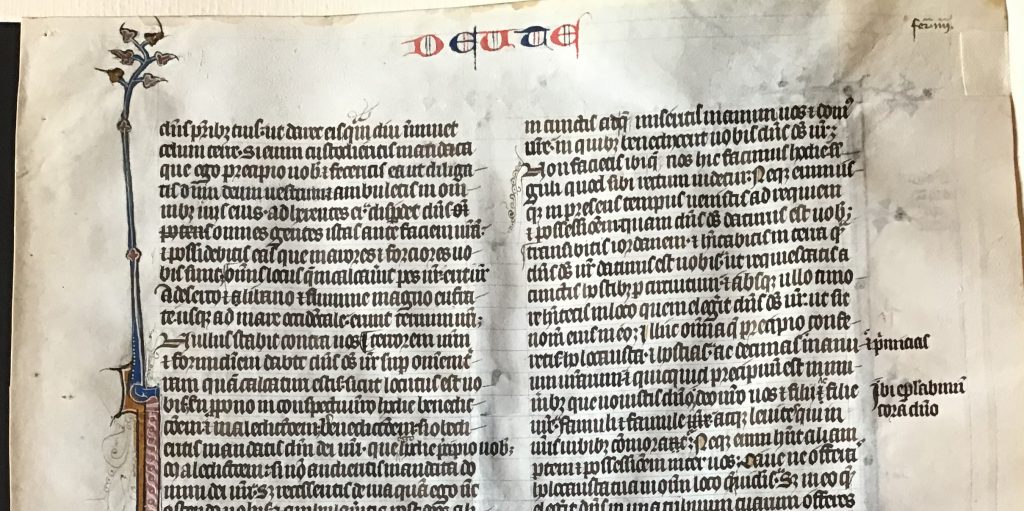
Brent Rosenbrook Collection, Leaf from Ege Manuscript 14, ‘Verso’ (original Recto), top.
At the right-hand edge, three more-or-less equally spaced pieces of tape attach the leaf to the back board of the mat. By such means, the leaf might be turned vertically on their hinges to lift it partway from the board and allow its other side to come into view. Such engineering is part-and-parcel of the Ege Method of placing specimen leaves within the windowed mats.
On this leaf, however, the original Ege mounting tapes have undergone repair, replacement, and reinforcement. Some other Ege leaves in, or from, Ege mats retain their ‘original’ tapes only in part — as here, with the stains of their adhesive and bits of some of their threads. (See, for example, A New Leaf from ‘Otto Ege Manuscript 8’). As here, some of them have subsequently added strips of tape, to strengthen or to replace the earlier ones. Here, some added and repositioned tapes do both.

Brent Rosenbrook Collection, Leaf from Ege Manuscript 14, ‘Verso’ (original Recto), lower right: Overlapping mounting tapes.
The Rulings
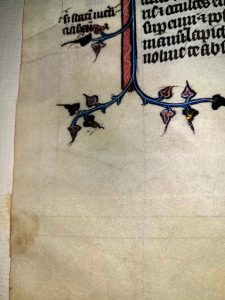
Brent Rosenbrook Collection, Leaf from Ege Manuscript 14, ‘Recto’ (original Verso), bottom right. Photograph enhanced to emphasize the ruled lines.
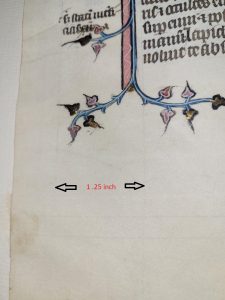
Brent Rosenbrook Collection, Leaf from Ege Manuscript 14, original Verso, bottom right: Inner and Outer Rulings.
Double sets of straight lines ruled in drypoint set out the framework to guide the lines of text within the double columns and the elements of decoration or other marks which extend into, or stand within, the margins. The drypoint rulings, impressed with a stylus or dull point of a knife drawn along a straight edge, left furrow-like impressions on the surface, without ink or pigment. Set into place, these same guides could perform their service on both sides of the leaf, and perhaps on several leaves in a stack.
The sets of vertical bounding lines for the columns of text and for the outside margins comprise parallel pairs of lines. The pair of ‘doubled lines’ at the left-hand side of a column could guide not only the left-hand side of the text, but also the vertical bars for the inset initials.
The framework measures approximately 1 1/4″ wide between outer and inner vertical line. The ruled area for the column of text itself measures circa 7 1/4″ wide.
The Text and C0rrections
The course of the main text demonstrates that the leaf formerly held its ‘Recto’ as the original Verso, and vice versa. Its text from the Book of Deuteronomy runs from partway through Chapter 11:21 ([quam iuravit] /) dominus patribus) to partway through Chapter 14:15 (strutionem ac noc-(/tuam et larum]). At the end of column b on the original Verso, the text breaks off mid-word, leading to the next leaf (now lost). Between the front and back of the leaf, the text continues its course within 12:25, with a page-break at feceris quod / placet in conspectu.
Corrections in the margins supply words or phrases alongside column b of the original Recto for within 12:11, at the beginning of 12:12, and within 12:22. On the original Verso, they do so for 12:27 alongside column a and for 14:6 alongside column b.
The Chapter Initials
Within their frames, the nested initials contain ornamental patterns against shining gold backgrounds, ready to catch the light. The letter-forms either fill the rectangular frame (S) or extend their backs or tails far beyond its confines into the margin or intercolumn (h and f). In the latter cases, the bar border itself (or part of it) assumes extra duty as part of the letter. In the former, the bar border remains a decorative band edging the column.
Deuteronomy 12:1 (H for Haec)
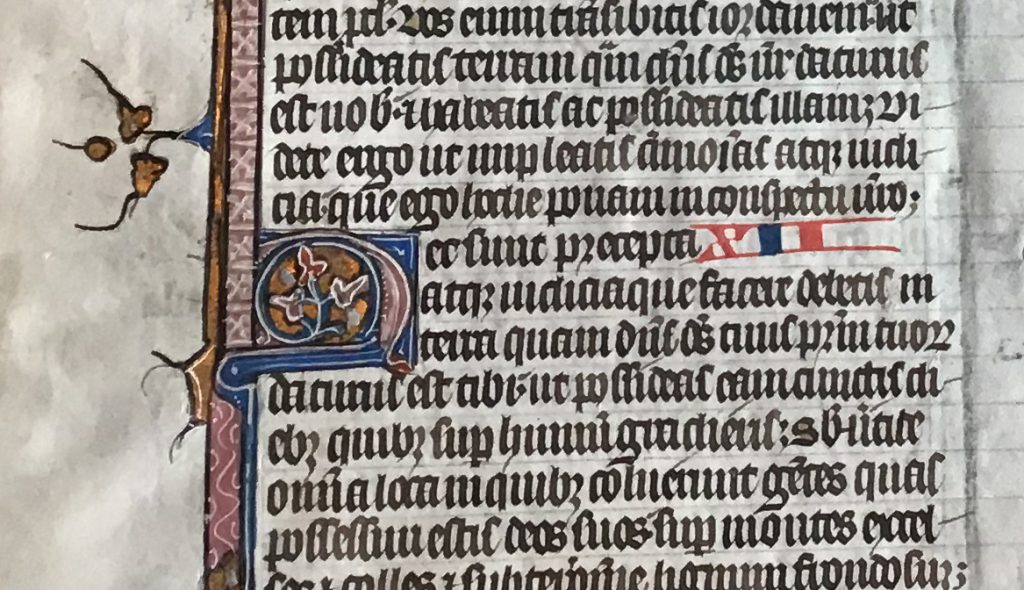
Brent Rosenbrook Collection, Leaf from Ege Manuscript 14, ‘Recto’ (original Verso), middle right: Deuteronomy XII opens.
Deuteronomy 13:1 (S for Si) and 14:1 (F for Filii)
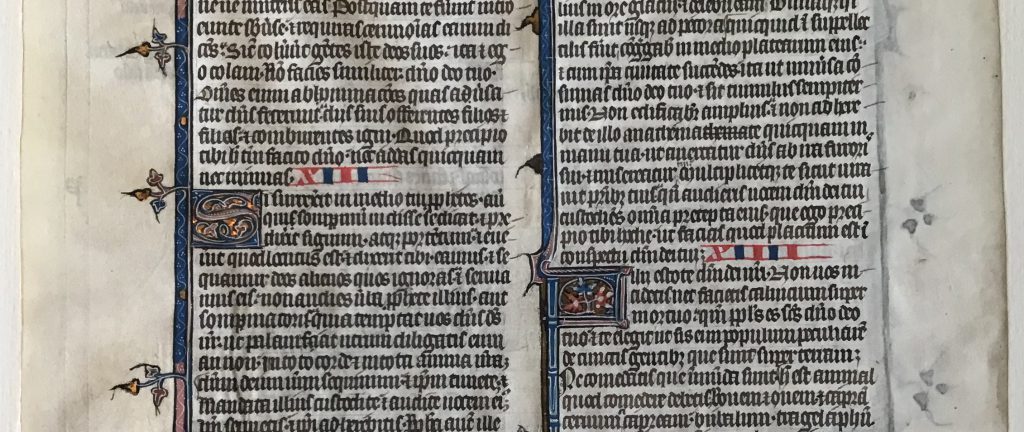
Brent Rosenbrook Collection, Leaf from Ege Manuscript 14, ‘Recto’ (original Verso), middle: Deuteronomy XIII and XIV.
Decorated Verse Initials with Pen-Line Extensions
On the verso, a couple of initials for Verses within the Chapters receive embellishment. The N of Nullus for verse 11:25 and of Non for verse 12:8 not only have stretched crossbars daubed with yellow pigment, but also possess pen-flourishes descending into the margin as foliate motifs. The flourish from Nullus calls for the vertical bar of the chapter initial lower down the the column to deviate its course around it, in the rise to the foliate terminal in the upper margin.
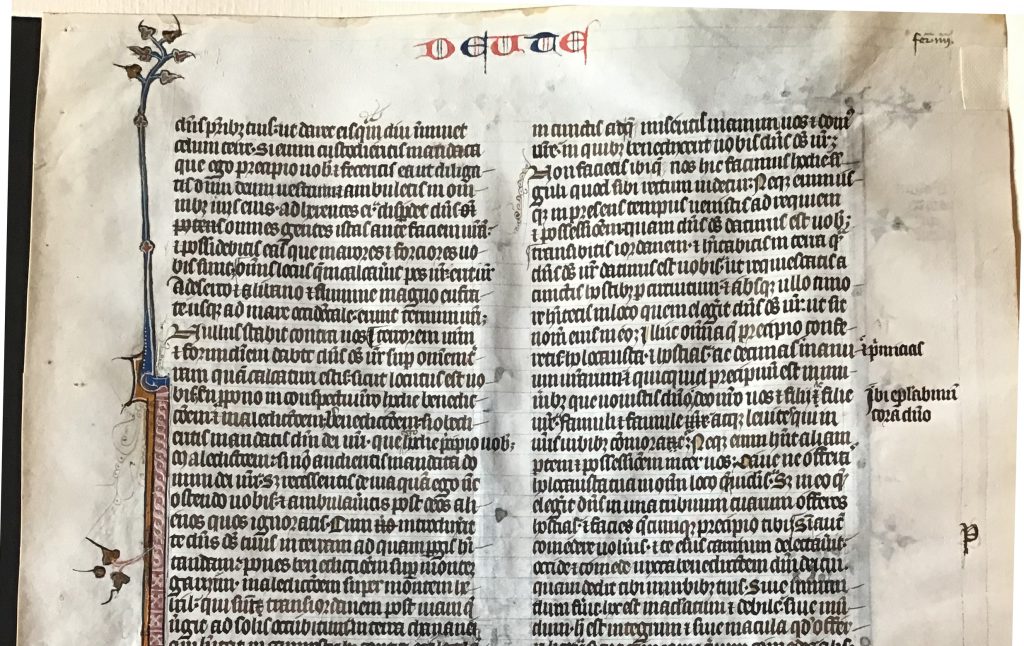
Brent Rosenbrook Collection, Leaf from Ege Manuscript 14, ‘Verso’ (original Recto), top.
The Running Titles

Brent Rosenbrook Collection, Leaf from Ege Manuscript 14, ‘Recto’ (original Verso), top: Running title.

Brent Rosenbrook Collection, Leaf from Ege Manuscript 14, ‘Verso’ (original Recto), top: Running title.
Each side of the leaf has one-half of the bipartite running title for DEUTE-/RONOMIUS at the top.
In a given Book, such titles would form a pair across the opening between two pages, on which they would read as a consecutive unit, proceeding from the one on the left-hand page (a verso) to the other on the right-hand page (a facing recto).
Other parts of the Old Testament retain two or more leaves from the same manuscript, so that their running titles might present a more-or-less direct view of the effect across the facing pages of an opening, with a verso at the left and a recto at the right. Such are the cases from parts of Exekiel and Esdras now in Cleveland and New Haven.
A Bifolium from Ezekiel at the Cleveland Museum of Art:
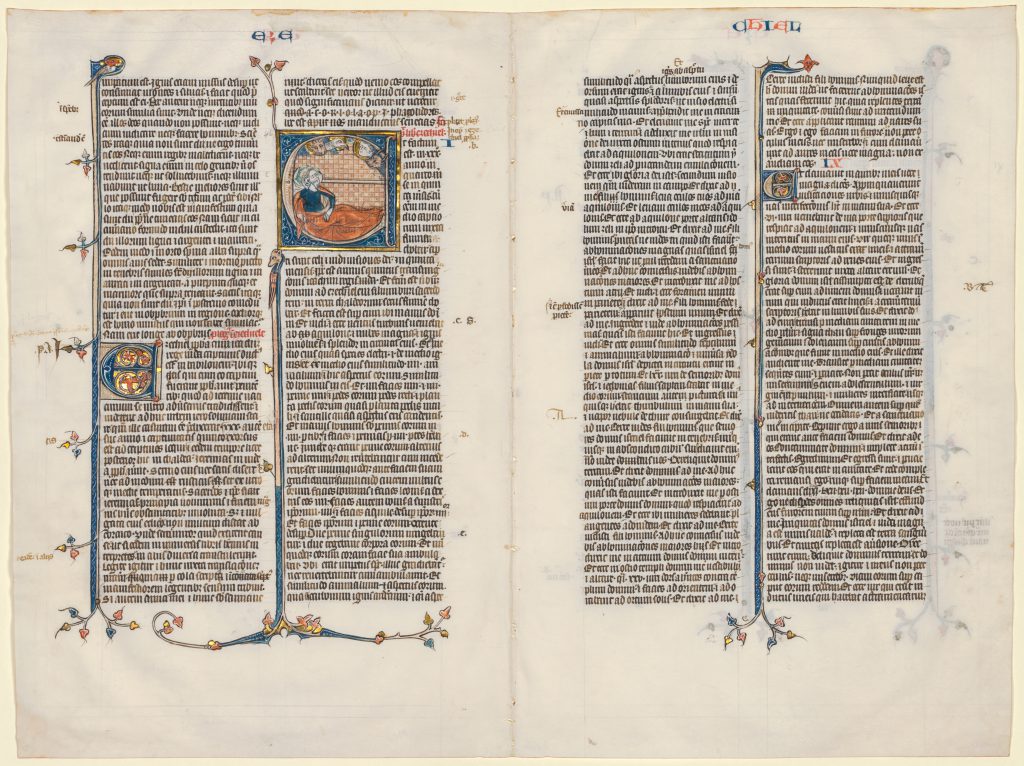
Cleveland Museum of Art, Bifolium from a Bible: (Ege MS 14), with parts of Ezekiel,via https://clevelandart.org. /art/1959.271. Image Public Domain via Creative Commons.
A bifolium from Esdras at the Beinecke Rare Book & Manuscript Library:
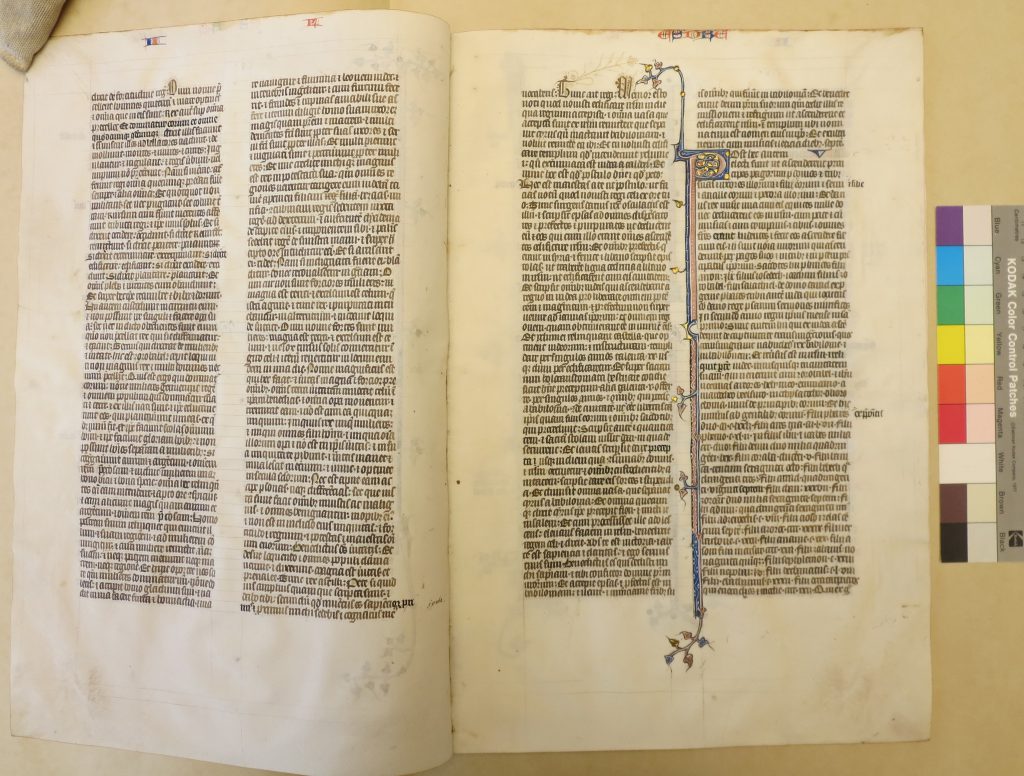
Beinecke Rare Book & Manuscript Library, Otto Ege Collection, Ege MS 14, Bifolium opened to 3 Esdras 2:16 to 5:19. Photograph Mildred Budny.
The Cleveland Exekiel Bifolium was removed from its gathering and separated from some leaves formerly nested between it, leaving the text on its two leaves discontinuous. Its present effect when the bifolium is opened emulates the original effect of the bipartite running titles ‘opened up’ to consecutive view, albeit for the halves of both their former openings in a non-original, conflated version. The Beinecke Ezdras bifolium with consecutive text presents an original opening, but only one leaf (the recto) has the name of the Book (in full) as running title, with numerals for the Chapters on the facing page.
Up close, the original Verso of the Rosenbrook Deuteronomy Leaf shows its part-title (-RONOM’I’US) which formerly appeared at the left-hand side of the opening, following from the first part of the title which stands on the opposite side of the leaf. Were the next leaf or the previous leaf to be discovered, we could know exactly how the two openings with the Rosenbrook Leaf as part of them presented the running title.
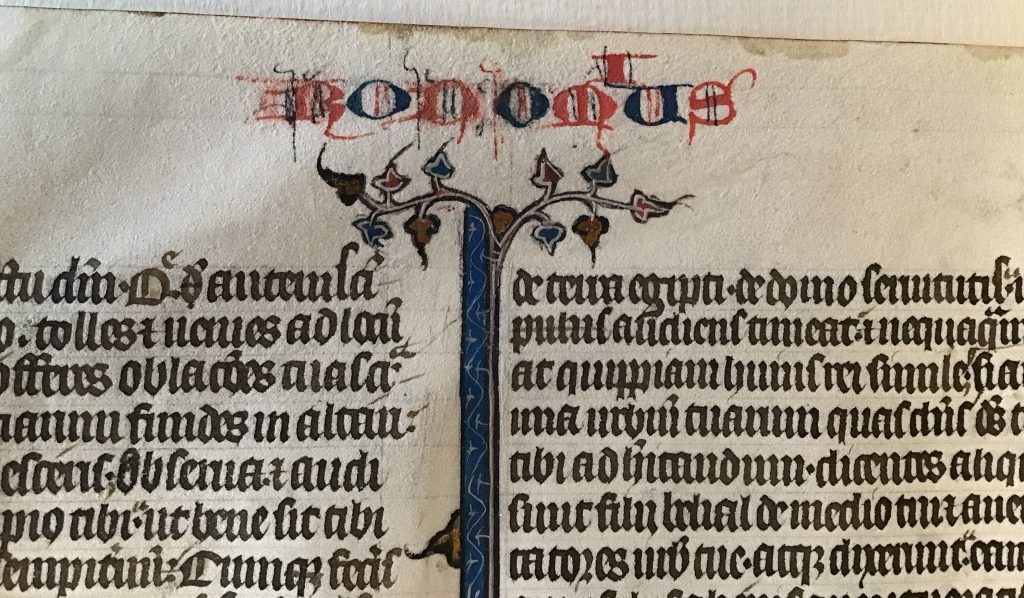
Brent Rosenbrook Collection, Leaf from Ege Manuscript 14, ‘Recto’ (original Verso), top: Running title.
The Inner Contour of the Displaced Leaf
Whereas many leaves from the manuscript which became reduced to single leaves under Ege’s transformation of the book retain the contours of their former gutters, or inner folds, along with parts of the stitching holes, this leaf does not appear to do so. The present inner edge of the leaf (at right on ‘Ege’s Verso’, actually the original Recto) shows an uneven contour, and little or no signs of the former fold-line and its stitching. It looks as though the cutting line took its course as the point of a sharp implement (say, a knife) or the blades of scissors worked across the surface free-hand at a short distance from the gutter, rather than along a fold-line. Without the adjacent leaves to compare and consult, it could seem impossible to know how this leaf formerly stood within its gathering, and if it belonged to a conjoint pair of leaves (‘bifolium’) folded into the nested leaves or bifolia of its quire.
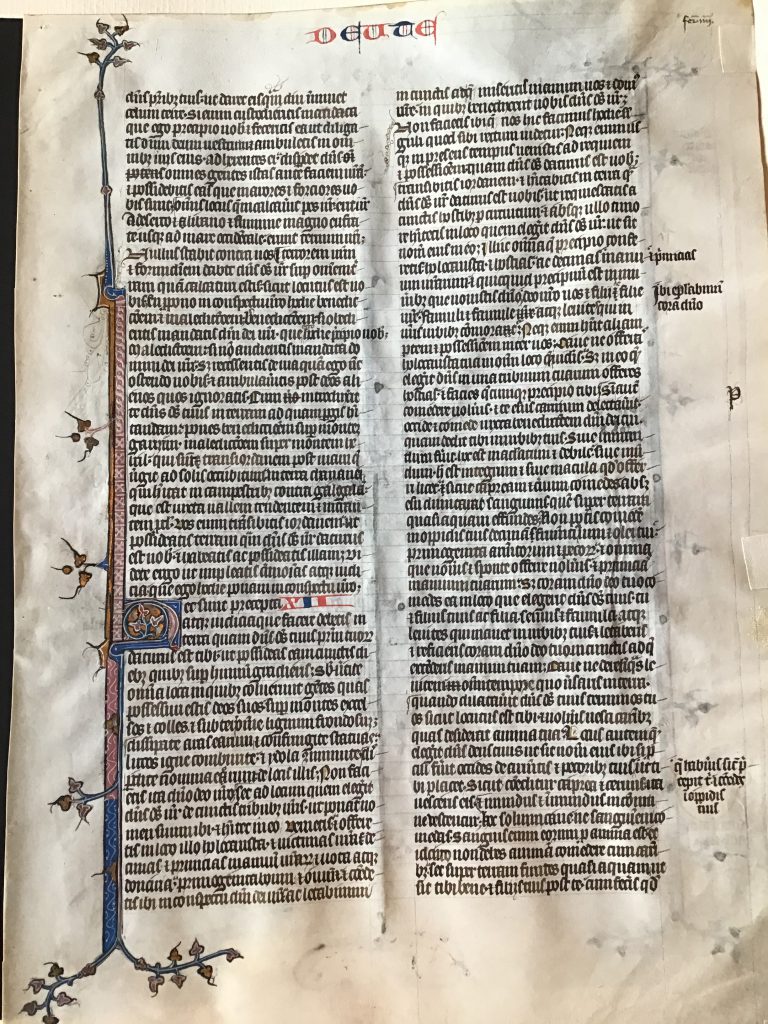
Brent Rosenbrook Collection, Leaf from Ege Manuscript 14, ‘Verso’ (original Recto).
A Deuteronomy Leaf at Stony Brook University
Another leaf from the Book of Deuteronomy approaches its running titles similarly. Its recto also carries a lection note for the feria at top right.
That leaf belongs to one of the numbered Sets of Otto Ege’s FOL Portfolio of Fifty Original Leaves from Medieval Manuscipts, as its Leaf Number 14.
Its text accounts for Deuteronomy 17:14 ([dabit ti-/]bi et possideris) – 20:19 (nec per circuitam se[sic for de-][/bes vastare]). Its lection note, feria v, written in the same script as the Rosenbrook Leaf, belongs to the same series. In the customary numeration (see above), Feria V would be a Thursday.
Recto
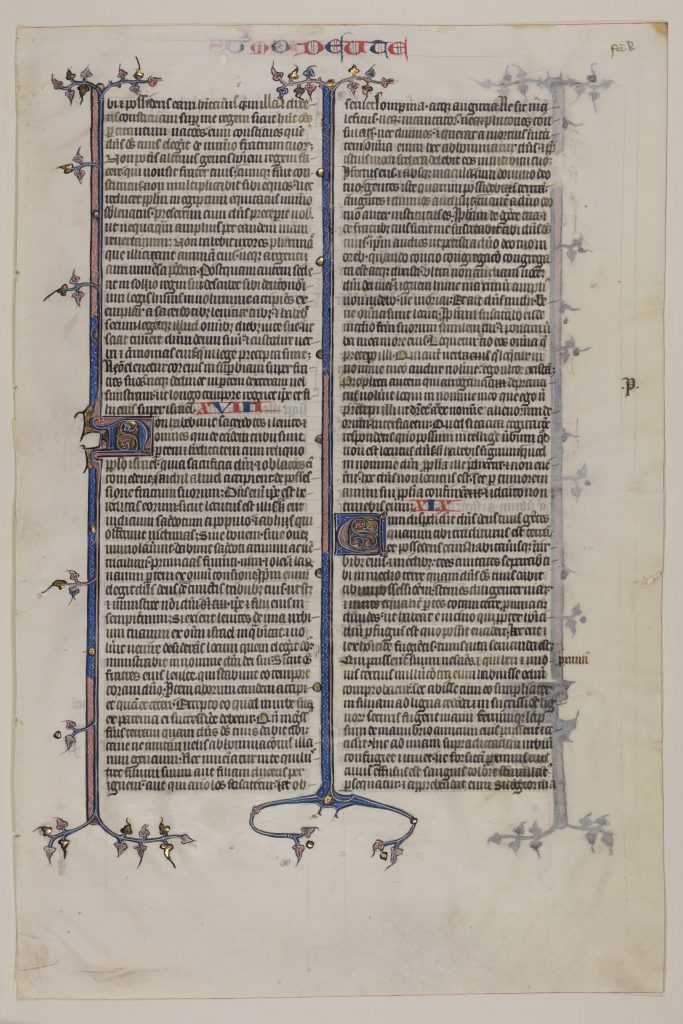
Otto F. Ege, “Fifty Original Leaves”, Leaf 14 recto, Special Collections and University Archives, Stony Brook University. Image Public Domain.
Verso
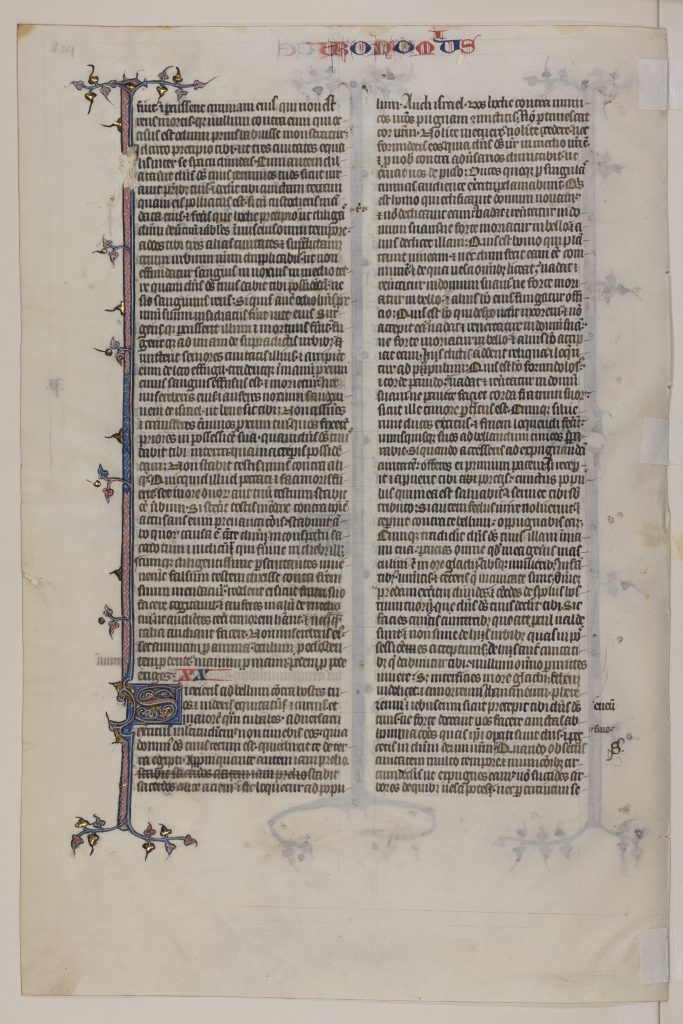
Otto F. Ege, “Fifty Original Leaves”, Leaf 14 verso, Special Collections and University Archives, Stony Brook University. Image Public Domain.
Animated or Inhabited Border
An earlier blogpost considers the partly-colored pen-line hybrid ‘Character’ interrupting the bar border on the verso of the Stony Brook University leaf. See A Leaf in Dallas from ‘Otto Ege Manuscript 14’.
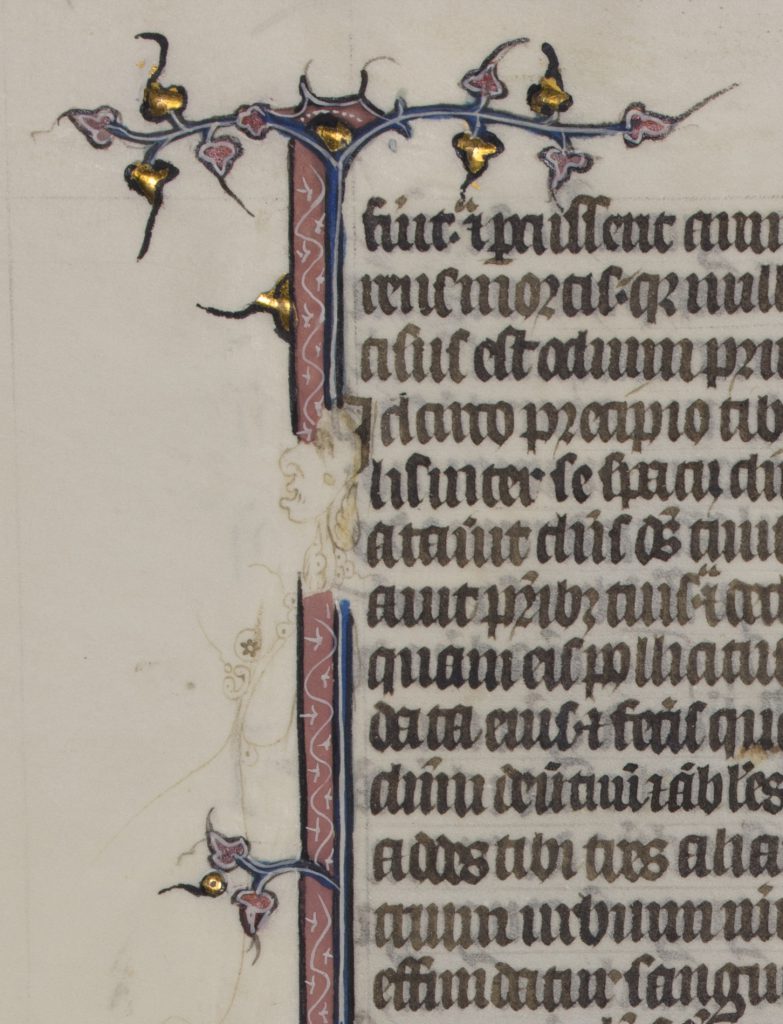
Otto F. Ege, “Fifty Original Leaves”, Leaf 14 verso, detail top left. Special Collections and University Archives, Stony Brook University. Image Public Domain.
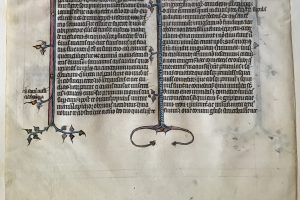
Brent Rosenbrook Collection, Leaf from Ege Manuscript 14, ‘Recto’ (original Verso), bottom.
Bar Borders, Chapter Initials, and Foliage in the Margins
Separated from each other by only a short distance in the original manuscript, both the Rosenbrook Leaf and the Stony Brook University leaf have similar layout for the bar borders and foliate extensions for their three inset chapter initials. Each leaf has one bar-border on one side of the leaf, and two, with one per column, on the other. Their foliate extensions into the upper and lower margins exhibit similar formations, even to the outward-branching and inward-curving pincer-like formations at the bottom center on the recto of the Stony Brook University leaf and the original recto of the Rosenbrook Leaf.
Running Titles Revisited

Brent Rosenbrook Collection, Leaf from Ege Manuscript 14, ‘Recto’ (original Verso), top: Running title.
The running titles place the first part of the name of the book on the recto, and the second part on the verso.
DEUTE-/RONOMIUS.
Like the Rosenbrook Leaf, the I of –RONOM’I’US hovers in ‘superscript’ between two letters, and takes the same coloring as the M. The shared approach by both leaves close together in the same Book could mean that this position of the ‘inserted’ I arose not by accident, requiring an ad hoc correction, or at least that its continuation displays some intention, as a repeatable decorative effect.
The original inner edge of the Stony Brook Leaf — the left-hand edge on the recto, and the right-hand edge on the verso — shows an uneven cut which ran along the inner fold, or gutter, of the leaf. The somewhat undulating contour includes some slots which belonged to the stitching patterns by which the leaves, assembled in gatherings, were sewn into the volume.
Surviving bifolia, like the same bifolium from the Book of Ezekiel at the Cleveland Museum of Art, retain their inner fold, or gutter, and its set of stitching holes down the center line.

Cleveland Museum of Art, Bifolium from a Bible: (Ege MS 14), with parts of Ezekiel,via https://clevelandart.org. /art/1959.271. Image Public Domain via Creative Commons..
That evidence renders beyond doubt that, at least in this part of Deuteronomy, the bipartite running title begin the name on the recto and continue it onto the verso. Such a pattern might seem to run counter to an expectation that a bipartite running title should display the first element on a verso and the second on the facing recto (as in some other parts of the same manuscript). However, the pattern seems to call for a reading of the title from one side of the leaf to the other — as a detached leaf would constrain its viewers now to do. The practice would presumably present a non-consecutive reading for the two running titles across a single opening within a given Book.
Bref, the sequence of bipartite running titles on both the Rosebrook Leaf and the Stony Brook University leaf show that, on the strength of a first-element running title alone, it would have been unwise to construe the running title on the front-facing side of the Dallas Leaf (IUDI-[CUM]) as evidence of an original Recto. See A Leaf in Dallas from ‘Otto Ege Manuscript 14’, which offers an exercise in caution, as well as an exploration of multiple evidentiary cues.
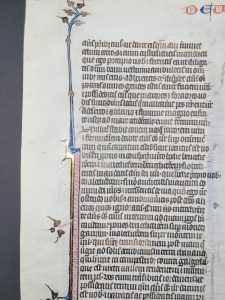
Reconstruction, Continued
For the Book of Deuteronomy, my earlier provisional Reconstruction of the manuscript (see More Discoveries for ‘Otto Ege Manuscript 14’) can be adjusted. The updates are signaled in red, with their links in blue.
Deuteronomy
1) Location unknown
- [? End of Numbers and] Opening of Deuteronomy]
2) Brent Rosenbrook Collection, Leaf from Otto Ege Manuscript 14.
- Deuteronomy 11:21 ([quam iuravit] /) dominus patribus) – 14:15 (strutionem ac noc-(/tuam et larum])
[Location unknown: Deuteronomy 14:15 — 17:14]
3) Stony Brook, New York, Stony Brook University Libraries, Special Collections and University Archives, Otto F. Ege: Fifty Original Leaves from Medieval Manuscripts and Complete Work (FOL Portfolio Set number 19), Leaf 14
- Deuteronomy 17:14 ([dabit ti-/]bi et possideris) – 20:19 (nec per circuitam se[sic for de-][/bes vastare])
Perhaps other survivors might join this list, as they come to light.
*****
I thank Brent Rosenbrook for bringing the leaf to our attention, sending images, answering questions, and giving the opportunity to study it and publish it. We are grateful for the permission to reproduce the images here.
We continue to thank the librarians, scholars, owners, and others, who have helped the continuing research in many ways.
*****
Do you know of more leaves from this manuscript? Do you recognize the hands of these scribes, artists, and annotators in other manuscripts?
You might reach us via Contact Us or our Facebook Page. Comments here are welcome too. We look forward to hearing from you.
Watch our blog on Manuscript Studies for more discoveries. Please visit its Contents List.
P. S. Note that more discoveries for Ege MS 14 await their own blogposts, as more readers of our blog join the conversation. Watch this space!
[Update: Now see Two Old Testament Leaves from ‘Otto Ege Manuscript 14’ at Smith College.]
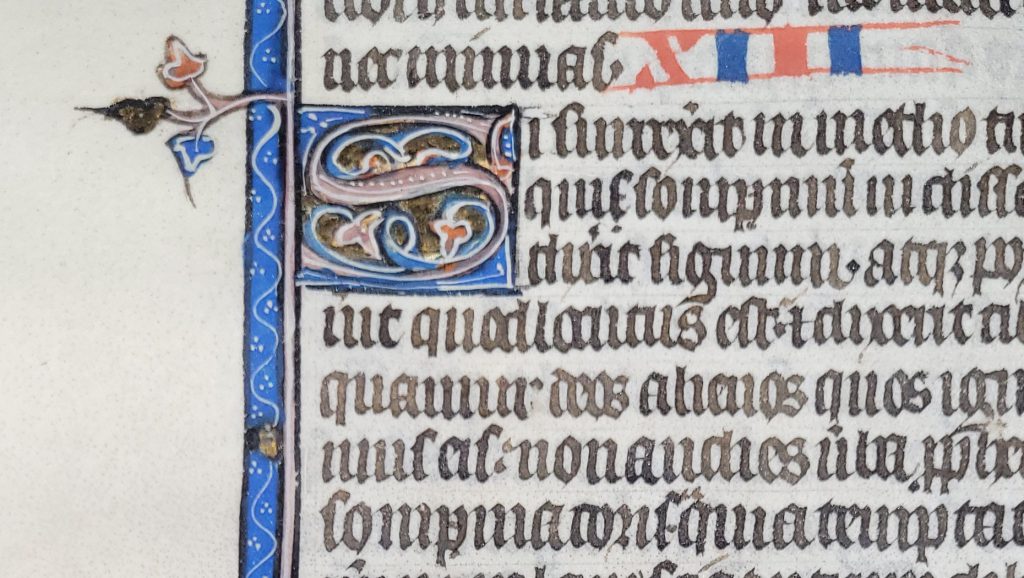
Brent Rosenbrook Collection, Leaf from Ege Manuscript 14, original Verso: Chapter XIII.
*****

This leaf comes from Ege “Fifty Original Leaves” portfolio no. 39, sold at Christie’s, 30 January 1980, lot 212, bought by Maggs for £2,600.
This can be deduced from the fact that one of the inscriptions is a characteristic Maggs acquisition code:
C 1/80 = Christie’s, January 1980
hesoo = £150.00
Dear Peter, Thank you for the information. It is always good to learn from your generous expertise. Your observations in your blog on Medieval Manuscripts Provenance are well worth following. https://mssprovenance.blogspot.com/
Thank you Milly for this post, and Peter for this comment! Now I have to go through my Beauvais Missal leaves to see if any have this annotation…
Sorry, should have written “my images of”, not just “my”!
Hello Lisa, Glad to hear from you. We are glad that you find the post, Peter’s comment, and the discussion useful. We look forward to more developments in your discoveries for the Beauvais Missal!
One thing which is not fully explain is the observation : Midway down that margin, there stands a lection mark: a capital letter P in ink.
The letter P is connected with the mark in the top right corner : fer[ia] iiij.
The letter P stands fort he Lectio prima or the first lesson read during the night office. It is exactly on the same place as in the Carthusian Bible from the Grande Chartreuse (Grenoble, Bibliothèque municipale, ms 1, fol. 104v) https://pagella.bm-grenoble.fr/img-viewer/Ms/Ms0001/viewer.html?base=BMG&np=&ns=B381856103_Ms0001B104v.JPG
The readings of the Heptateuch start on the Sunday of Septuagesima. Genesis and Exodus were which read in one week. Leviticus in four days and Numbers in 10 days. Deuteronomy again in one week. The beginning of Septuagesima depends of Easter Sunday. Al earliest i twill be January 18 and at latest on February 22. What means that the reading of Deuteronomy start on February 16 (latest on March 23). The Wednesday after will be Febbruary 19 (latest March 26).
When the next leave will be found the letter S (lectio secunda) will be in the margin next to “Decinam partem separabis de cunctis frugibus” (Deut. 14, 22).
Because this reading system is unique for the bibles used in the Carthusian monasteries it is clear that Ege Otto ms 14 was once used in such a monastery.